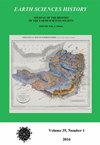Research of Functional and Technological Properties of Persimmon Fruits as an Object of Drying
IF 0.6
4区 哲学
Q4 GEOSCIENCES, MULTIDISCIPLINARY
引用次数: 0
Abstract
Persimmon fruits should be initially quite hard, so that they can not only be easily peeled, but also fastened with a strong rope for the closely adjacent stems and dried for a month or two under a canopy. Despite the extensive nature of this process, farmers are used to this artisanal method and the small profit it can provide in those 3-4 post-harvest weeks, as long as the persimmon can remain firm. The aim of this work was to develop more efficient alternative drying methods that allow drying persimmons in an accelerated mode and at all stages of its post-harvest storage. The objects of the study were the fruits of the cultivars "Hachiya" and "Hiakume", grown in the experimental farm of the Research Institute of Horticulture and Tea Industry (Guba, Azerbaijan). The method of creating the final products was used, based on taking into account the physical and chemical changes that occur in the persimmon during its maturation. It was found that the natural balance between lecoanthocyanins (the most tart among polyphenols), protopectin, which refers to insoluble dietary fiber and easily digestible carbohydrates, does not provide the best color and taste of 100% dried persimmon from early solid raw materials. Slicing slices of hard fruit into slices 2-3 mm thick and holding the slices for 10-15 minutes in solutions of table salt and sugar allows you to improve their color and taste initially. Aged softened fruits are amazingly delicious and without additives. Taking into account these and other revealed facts, technologies were developed for obtaining natural chips from solid persimmons, and 100% dried persimmons from softened persimmons. Calculations have shown that the proposed technologies are cost-effective and promising for wide application.作为干燥对象的柿子果实的功能与工艺特性研究
柿子最初应该很硬,这样不仅可以很容易地去皮,还可以用结实的绳子把紧挨着的茎系住,在树冠下晒一两个月。尽管这一过程具有广泛的性质,但农民们已经习惯了这种手工方法,只要柿子能保持坚挺,在收获后的3-4周内,它就能带来微薄的利润。这项工作的目的是开发更有效的替代干燥方法,允许在加速模式和收获后储存的所有阶段干燥柿子。研究的对象是栽培在阿塞拜疆古巴园艺和茶业研究所实验农场的“Hachiya”和“Hiakume”品种的果实。制作最终产品的方法是基于考虑到柿子在成熟过程中发生的物理和化学变化。研究发现,作为早期固体原料的100%柿干,其色素(多酚类物质中最酸的一种)、不溶性膳食纤维和易消化碳水化合物原蛋白之间的自然平衡并不能提供最佳的色泽和口感。将坚硬的水果切成2-3毫米厚的薄片,在食盐和糖的溶液中浸泡10-15分钟,可以初步改善它们的颜色和味道。陈年软化的水果非常美味,不含添加剂。考虑到这些和其他揭示的事实,人们开发了从固体柿子中获得天然薯片的技术,从软化柿子中获得100%干柿子的技术。计算表明,所提出的技术具有成本效益和广泛的应用前景。
本文章由计算机程序翻译,如有差异,请以英文原文为准。
求助全文
约1分钟内获得全文
求助全文
来源期刊

Earth Sciences History
GEOSCIENCES, MULTIDISCIPLINARY-HISTORY & PHILOSOPHY OF SCIENCE
CiteScore
1.00
自引率
0.00%
发文量
1
审稿时长
>12 weeks
期刊介绍:
Earth Sciences History promotes and publishes historical work on all areas of the earth sciences – including geology, geography, geophysics, oceanography, paleontology, meteorology, and climatology.
The journal honors and encourages a variety of approaches to historical study: biography, history of ideas, social history, and histories of institutions, organizations, and techniques.
Articles are peer reviewed.
 求助内容:
求助内容: 应助结果提醒方式:
应助结果提醒方式:


